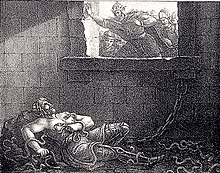
Quick Facts
Biography
Ælla (or Ælle) (fl. 866; d. 21 March 867) was King of Northumbria, England in the middle of the 9th century. Sources on Northumbrian history in this period are limited, ancestry is not known and the dating of the beginning of Ælla's reign is questionable.
In addition to the Anglo-Saxon Chronicle, Ælla is also mentioned in Scandinavian sources, such as the Norse sagas. According to the latter, Ælla captured the semi-legendary Swedish-Danish Viking leader Ragnar Lodbrok, whom Ælla put to death in a pit of snakes. The historical invasion of Northumbria in 866 occurred in retaliation for Ragnar's execution, according to Ragnarssona þáttr ("The Tale of Ragnar's Sons"). While Norse sources claim that Ragnar's sons tortured Ælla to death with a blood eagle, Anglo-Saxon accounts maintain that he died in battle, at York, on 21 March 867.
Anglo-Saxon accounts
Ælla became king after Osberht (Osbryht) was deposed. This is traditionally dated to 862 or 863 but evidence about Northumbrian royal chronology is not decisive about dates prior to 867 and it may have been as late as 866. Almost nothing is known of Ælla's reign; Symeon of Durham states that Ælla had seized lands at Billingham, Ileclif, Wigeclif and Crece, which belonged to the church. While Ælla is described in most sources as a tyrant and not a rightful king, one source states that he was Osberht's brother.
The Great Heathen Army, composed mostly of Danish Vikings, landed in Northumbria in mid-866 and had captured York by 21 November.
Subsequent events are described by historians such as Symeon of Durham, Asser and Æthelweard in accounts that vary only in detail. According to the Historia Regum Anglorum, following the invasion of the Danes, the previous "dissension" between Osberht and Ælla "was allayed by divine counsel" and other Northumbrian nobles. Osberht and Ælla "having united their forces and formed an army, came to the city of York" on 21 March 867. A majority of the "shipmen" (Vikings) gave the impression of fleeing from the approaching Northumbrians. "The Christians, perceiving their flight and terror", attacked, but found that the Vikings "were the stronger party". Surrounded, the Northumbrians "fought upon each side with much ferocity" until both Osberht and Ælla were killed. The surviving Northumbrians "made peace with the Danes".
After this, the Vikings appointed a puppet king of Northumbria, named Ecgberht. According to an Anglo-Norman genealogy, Ælla had a daughter named Æthelthryth and through her was the grandfather of Eadwulf of Bamburgh, "King of the Northern English" who died in 913.
The Anglo-Saxon Chronicle does not name the Viking leaders, but it does state that "Hingwar and Hubba" (probably Ivar and Ubba) later killed King Edmund of East Anglia. Ubba was also named as a leader of the army in Northumbria by Abbo of Fleury and by the Historia de Sancto Cuthberto. Symeon of Durham lists the leaders of the Viking army as "Halfdene [Halfdann], Inguar [Ingvar], Hubba, Beicsecg, Guthrun, Oscytell [Ketill], Amund, Sidroc and another duke of the same name, Osbern, Frana and Harold."
Norse sources

According to Ragnarssona þáttr, the army that seized York in 866 was led by Hvitserk, Björn Ironside, Sigurd Snake-in-the-Eye, Ivar the Boneless and Ubba, sons of Ragnar Lodbrok, who avenged his death by subjecting Ælla to the blood eagle. However, Anglo-Saxon sources claim that Ælla and Osberht died in battle at York, with the Anglo-Saxon Chronicle stating that "both the kings were slain on the spot".
Ivar the Boneless, who plays a major role in both Norse and Anglo-Saxon accounts, is sometimes associated with the Viking leader Ímar (Old Norse: Ívarr), a King of Dublin mentioned in the Irish annals. This is unlikely, however, as Ímar's father is usually said to be Gofraid of Lochlann and his brothers are usually named as Amlaíb Conung and Auisle. As Dorothy Whitelock notes, the names Ívarr and Ímar were "not uncommon" in Norse societies.
Popular culture
Ælla was played by Frank Thring in the film The Vikings (1958) as the main antagonist.
A character broadly based on Ælla is played by Ivan Kaye in the History Channel's drama series Vikings (2013). The show has no indication that this Ælla has ursurped his throne and is shown to have reign in Northumbria for more than one and a half decade. He is shown to be executed by blood eagle after a battle which is said to stand "near work".
In The Last Kingdom, a historical novel by Bernard Cornwell, Ælla appears very briefly as a minor character at the beginning of the book. He, along with Osberht and Uhtred, a fictional Ealdorman of Bernicia, lead a Northumbrian army to repel invading Danes at York. The battle ends disastrously for the Northumbrians when the Norse army feints a retreat, and Ælla dies on the field.
